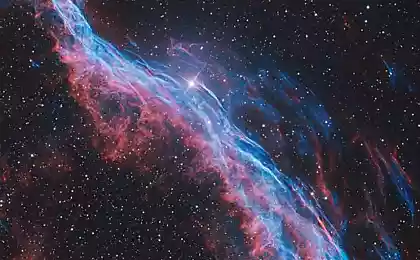549
Which organisms are able to survive on Proxima Centauri b under the flashes of hard ultraviolet radiation from the red dwarf?

August 24 the world's media had spread the news about the discovery of extrasolar planets in our nearest star Proxima Centauri, at a distance of only 1, 295 parsecs (4, 22 light years) from the solar system.
Technically, the planet is Proxima Centauri b really meets the definition of "Earth's twin," that is, the size, mass and temperature regime corresponds approximately to the world, has the potential to be suitable for life and allows for the existence of liquid water. The minimum mass of the planet is 1, 27 of the earth, the radius of ≥1, 1 ± 0, 3 R⊕, it is in the habitable zone of a red dwarf class the M5, the period of revolution around the star 11, 186 days.
As always, the devil is in the details. If you look at the actual climatic conditions Proxima b, then optimism mass media seems a little redundant. The fact that Proxima Centauri - is extremely unstable star that erupts every 10-30 hours, including ultraviolet and X-ray. "Man survive in these conditions will be, to put it mildly, difficult," - commented the head of the discovery of American astronomers photometry laboratory and infrared radiometry department of physics of planets and small bodies of the solar system Space Research Institute of Russian Academy of Sciences, Professor Leonid Ksanfomaliti
. A UV flash power have sufficient energy to break bonds in the DNA molecule. A particularly devastating impact of radiation has a shorter wavelength. enough to irradiate the complete destruction of microorganisms UV with a wavelength of about 260 nm for a certain period of time.

Proxima Centauri b is very close to its star
The intensity of UV radiation at the surface of the star flashes Proxima Centauri b by several orders of magnitude greater than the intensity of solar radiation at the Earth's surface. The situation is exacerbated by the fact that due to the proximity to the star, the planet's magnetic field can be compressed and less atmosphere to protect Proxima Centauri b.

UV activity on the surface of a hypothetical planet's atmosphere, which is located at a distance of 1 AU near the active star AD Leo the M3-class, 5 in the normal state (gray) and during outbreaks (blue) compared to solar UV radiation entering the earth's atmosphere (gray dashed line)
But there is hope. Theoretically, Proxima Centauri b still life is possible, even with such powerful flares of ultraviolet radiation, astrobiologists believe American Jack O'Malley-James (Jack T. O'Malley-James) and Lisa Kaltenegger (Lisa Kaltenegger) of the Institute. Carl Sagan at Cornell University.
According to them, some creatures are able to escape from the deadly ultraviolet radiation, using natural cover. For example, they can exist under the ground or in deep water.
Furthermore, astrobiologists pay attention to another possible form of potentially life which is able to convert the resulting energy into bioflyuorestsentnoe radiation with different wavelength. In this process are utilized special protective proteins that absorb harmful UV radiation.
The astrophysicists cite the example of earthly form of life - coral polyps. Some types of corals contain fluorescent proteins that photoactivating irradiation with ultraviolet light in the long wavelength range A at wavelengths 315-400 nm and in the blue region of the spectrum 420-700 nm and converting it into radiation with a longer wavelength. Perhaps coral polyps fluorescence is a defensive reaction to eliminate harmful UV.

Example coral bioflyuorestsentsii
The following table lists the four most common fluorescent protina in korralovyh polyps.
Peak emission (nm) excitation range (nm) fluorescence efficiency (%) 486 350-475 3-5 515 400-525 10-12 575 350- 685 350-650 575 8-10 1-2 fluorescence efficiency increases with increasing intensity of UV radiation. That is Proxima Centauri b efficiency should be much higher than that of the coral polyps.
For more information about bioflyuorestsentsii coral polyps refer to scientific works of Maxim Gorbunova and colleagues "Photosynthesis and photoprotection in symbiotic corals" (Gorbunov, MY, Kolber, ZS, Lesser, MP & amp; Falkowski, PG 2001. Limnol Oceanogr, 46:.. 75. - 85), as well as the article "Contribution of fluorescence to the spectral signature and perceived color of corals" (Mazel, CH, \ & amp; Fuchs, E. 2003 Limnol.Oceanog, 48, 390)
.. If living organisms on Proxima Centauri b mastered this method of energy conversion, this planet may very strong light at certain wavelengths, it is possible, even in the visible range. Scientists believe that such a powerful glow can be seen from Earth. In his scientific work, they proposed several models of fluorescence indicating the wavelength on which to look for the glow of alien life forms.
The work of scientists and more important because red dwarfs of spectral type M - is not only Proxima Centauri. In fact, the stars of this type represent 75% of the nearest stars to the Solar System. Preliminary observations suggest the existence of three Earth-sized planets in similar star TRAPPIST-1 class M8, which is also located close to the solar system. Some of the possible orbits of the outermost of these planets TRAPPIST-1d are in the habitable zone.

nearest environment of the solar system. Data source: NASA. Graphics: A. Cuadra / Science
In 2017, NASA plans to launch a space telescope TESS (Transiting Exoplanet Survey Satellite), which will carefully study the transit of exoplanets orbit around nearby bright stars in the solar system. It is assumed that TESS will find hundreds of planets radius of 1, 25-2 on the ground, and dozens of Earth-sized planets. It is also estimated that up to 20 of these planets will be in the habitable zone around their cold stars. So that Proxima Centauri b -. Only the first of dozens of similar worlds which we will open in the near future

Estimated landscape Proxima Centauri b. Render: ESO / M. Kornmesser
Scientific work "Biofluorescent Worlds: Biological fluorescence as a temporal biosignature for flare stars worlds" is published in the public domain at arXiv.org
. Source: geektimes.ru/post/279904/
She fell asleep at the university and then it started
Why we still do not have a new generation of batteries?























